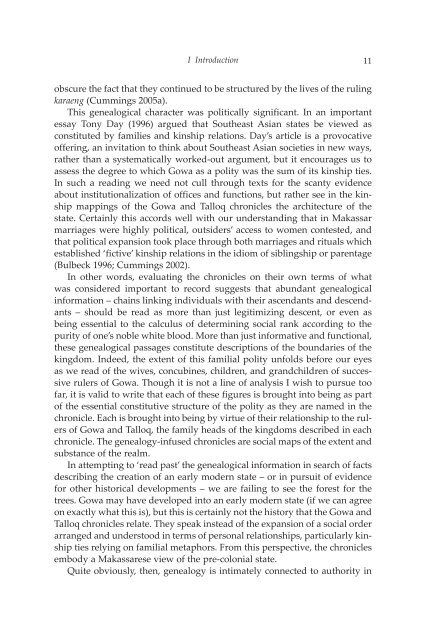A CHAIN OF KINGS - Books and Journals
A CHAIN OF KINGS - Books and Journals
A CHAIN OF KINGS - Books and Journals
Create successful ePaper yourself
Turn your PDF publications into a flip-book with our unique Google optimized e-Paper software.
I Introduction 11<br />
obscure the fact that they continued to be structured by the lives of the ruling<br />
karaeng (Cummings 2005a).<br />
This genealogical character was politically significant. In an important<br />
essay Tony Day (1996) argued that Southeast Asian states be viewed as<br />
constituted by families <strong>and</strong> kinship relations. Day’s article is a provocative<br />
offering, an invitation to think about Southeast Asian societies in new ways,<br />
rather than a systematically worked-out argument, but it encourages us to<br />
assess the degree to which Gowa as a polity was the sum of its kinship ties.<br />
In such a reading we need not cull through texts for the scanty evidence<br />
about institutionalization of offices <strong>and</strong> functions, but rather see in the kinship<br />
mappings of the Gowa <strong>and</strong> Talloq chronicles the architecture of the<br />
state. Certainly this accords well with our underst<strong>and</strong>ing that in Makassar<br />
marriages were highly political, outsiders’ access to women contested, <strong>and</strong><br />
that political expansion took place through both marriages <strong>and</strong> rituals which<br />
established ‘fictive’ kinship relations in the idiom of siblingship or parentage<br />
(Bulbeck 1996; Cummings 2002).<br />
In other words, evaluating the chronicles on their own terms of what<br />
was considered important to record suggests that abundant genealogical<br />
information – chains linking individuals with their ascendants <strong>and</strong> descendants<br />
– should be read as more than just legitimizing descent, or even as<br />
being essential to the calculus of determining social rank according to the<br />
purity of one’s noble white blood. More than just informative <strong>and</strong> functional,<br />
these genealogical passages constitute descriptions of the boundaries of the<br />
kingdom. Indeed, the extent of this familial polity unfolds before our eyes<br />
as we read of the wives, concubines, children, <strong>and</strong> gr<strong>and</strong>children of successive<br />
rulers of Gowa. Though it is not a line of analysis I wish to pursue too<br />
far, it is valid to write that each of these figures is brought into being as part<br />
of the essential constitutive structure of the polity as they are named in the<br />
chronicle. Each is brought into being by virtue of their relationship to the rulers<br />
of Gowa <strong>and</strong> Talloq, the family heads of the kingdoms described in each<br />
chronicle. The genealogy-infused chronicles are social maps of the extent <strong>and</strong><br />
substance of the realm.<br />
In attempting to ‘read past’ the genealogical information in search of facts<br />
describing the creation of an early modern state ‒ or in pursuit of evidence<br />
for other historical developments ‒ we are failing to see the forest for the<br />
trees. Gowa may have developed into an early modern state (if we can agree<br />
on exactly what this is), but this is certainly not the history that the Gowa <strong>and</strong><br />
Talloq chronicles relate. They speak instead of the expansion of a social order<br />
arranged <strong>and</strong> understood in terms of personal relationships, particularly kinship<br />
ties relying on familial metaphors. From this perspective, the chronicles<br />
embody a Makassarese view of the pre-colonial state.<br />
Quite obviously, then, genealogy is intimately connected to authority in









![Am HaSefer [Volk des Buches] - Books and Journals](https://img.yumpu.com/20648352/1/174x260/am-hasefer-volk-des-buches-books-and-journals.jpg?quality=85)







